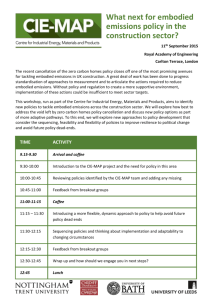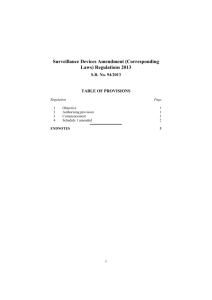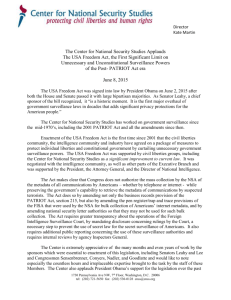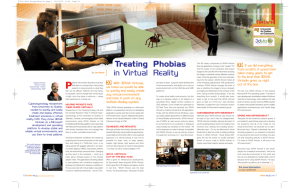CONCEPT-english
advertisement
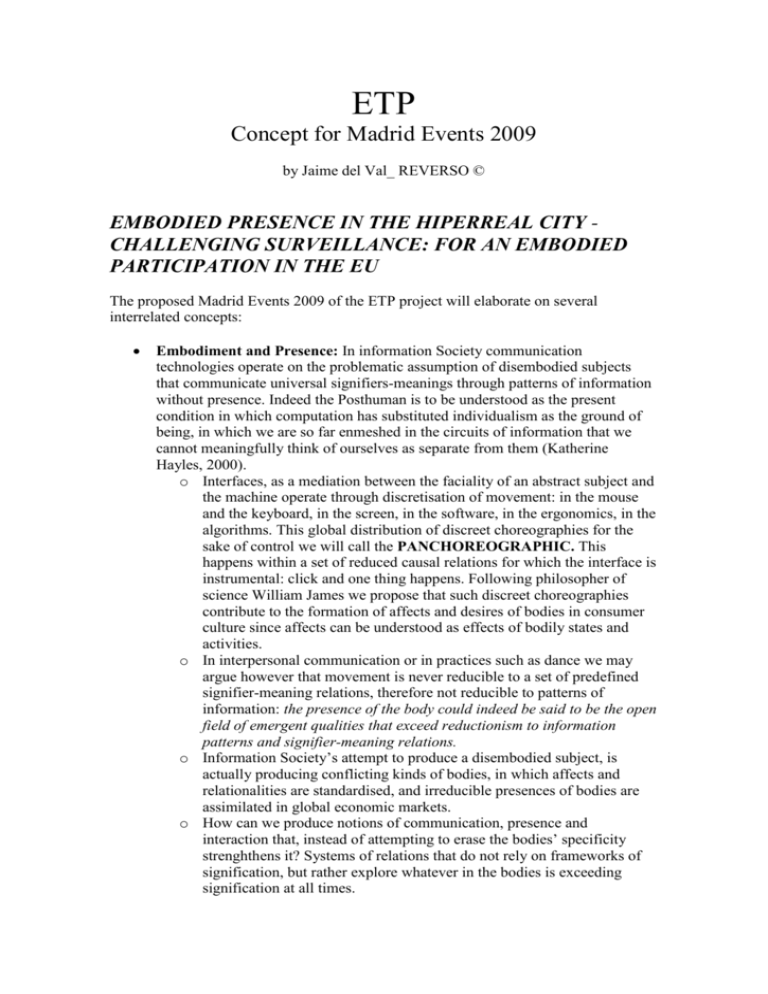
ETP Concept for Madrid Events 2009 by Jaime del Val_ REVERSO © EMBODIED PRESENCE IN THE HIPERREAL CITY CHALLENGING SURVEILLANCE: FOR AN EMBODIED PARTICIPATION IN THE EU The proposed Madrid Events 2009 of the ETP project will elaborate on several interrelated concepts: Embodiment and Presence: In information Society communication technologies operate on the problematic assumption of disembodied subjects that communicate universal signifiers-meanings through patterns of information without presence. Indeed the Posthuman is to be understood as the present condition in which computation has substituted individualism as the ground of being, in which we are so far enmeshed in the circuits of information that we cannot meaningfully think of ourselves as separate from them (Katherine Hayles, 2000). o Interfaces, as a mediation between the faciality of an abstract subject and the machine operate through discretisation of movement: in the mouse and the keyboard, in the screen, in the software, in the ergonomics, in the algorithms. This global distribution of discreet choreographies for the sake of control we will call the PANCHOREOGRAPHIC. This happens within a set of reduced causal relations for which the interface is instrumental: click and one thing happens. Following philosopher of science William James we propose that such discreet choreographies contribute to the formation of affects and desires of bodies in consumer culture since affects can be understood as effects of bodily states and activities. o In interpersonal communication or in practices such as dance we may argue however that movement is never reducible to a set of predefined signifier-meaning relations, therefore not reducible to patterns of information: the presence of the body could indeed be said to be the open field of emergent qualities that exceed reductionism to information patterns and signifier-meaning relations. o Information Society’s attempt to produce a disembodied subject, is actually producing conflicting kinds of bodies, in which affects and relationalities are standardised, and irreducible presences of bodies are assimilated in global economic markets. o How can we produce notions of communication, presence and interaction that, instead of attempting to erase the bodies’ specificity strenghthens it? Systems of relations that do not rely on frameworks of signification, but rather explore whatever in the bodies is exceeding signification at all times. o Bodies, understood as fields of relational forces that operate at multiple levels, are affective and intensive, rather than material and extensive. How can we produce conditions in which the radical openness of the way in which affects are embodied, is acknowledged and supported? o The project ETP provides a series of opportunities for such an experimentation: through stressing the non-representational character of the visual and sound environments that avoids the aesthetics of simulation and objectivity of the information era. through proposing amorphous and nearly abstract accounts of presence that defy the boundaries of cultural intelligibility of bodies, presences that are in the frontier of the intelligible, posthuman of metahuman presences in which the important thing is not to recognise standard features of a human agent, but to dance around diffuse qualities of an agency that could be human but doesn’t need not be so: an agency with no defined gender or sex, no defined class, race or species, no defined age or capacity or form, and yet potentially crossing multiple sexes, species and forms of the bodies. through exploring accounts of presence that don’t rely on the standardised recognition of culturally intelligible forms, but rather proposes a dissolution of these and experiments presence as a more open field of encounter with the unkown. through proposing metasignfying contexts of relation, that do not rely upon strategies of goal oriented interpretation, but rather open the field to processes of embodiment of affects. The city, the local: The city as lived body of relations can be analysed at various levels: o The lived city: what sensations, what kinds of relational intensity is the city constituted of through the interactions of the bodies that inhabit it: what are the experiential modes that constitute that metabody of relations: what is our experience of the city: can we translate it to parameters of choreographed movement (the speeds, directionalities, specific movements performed in the city), of sound and light and space perception, of proxemics and chronemics? o The intensive city – METABODY: To understand the city, space and architecture as a living body of relations, as intensity rather than a fixed extensive space. o The hiperreal city: the city of information and simulation, of publicity and ubiquitous screens, the city as machine for the affective production of bodies and for their assimilation in economic regimes of consumption, the city as semiotic landscape, the city as disciplinary grid, as biopolitical meta-mechanism of control and production: which are its surfaces of operation, through ubiquitous publicity and commercial music, and through the movements and choreographies that these distribute, through architecture and urban planning, through transport and communication technologies that make of public space a dissapearing reality, masked and inaccessible behind the façade of hiperreal Virtual Reality of the media? o The reverse of the city: every time we contribute to the economic regime in the city we are complicit with old and new forms of global violence that the system both hides and promotes: wars in Congo, exploitation in the Far East, climate change... unprecedented global violence in the global era that the system of consumption and its metabody, the city, effectively hides, through its surfaces of affective production. How can we make that violence visible? The EU and the illusions of public Participation: In a hipermodern world of media politics, what kinds of fake participation are citizens normally embedded in? In a European Union in which economic interests rate far above social and environmental criteria, citizens are often connected to telematic platforms of communication that give a certain feeling of participation. We argue however that such participation is a fake one, that generally serves the purposes of the large companies that design and choreograph WEB 2.0. We need an understanding of these platforms that deals with the ways in which at the same time as they seem to empower citizens, they take away possibilities for action, through producing the illusion of a free world and masking violence at global scale behind the culture of leisure and entertainment. Surveillance and control: We are increasingly surrounded by surveillance systems that look down on us from satellites and street corners, from the ceiling of the workplace, the tube or even in the house. The system employed in ETP, an infrared camera placed on the ceiling, is a paradigm of surveillance technologies, however through connecting it to a specific software for analysis and its mapping to the software processing image and sound, instead of subjecting bodies to goal oriented systems of analysis and surveillance, movement becomes an uncontrollable mapping strategy within metasignifying systems of relation, thus defying principles of interpretation on which surveillance rely. Therefore the project attempts to: o Promote embodied metasignifying, non representational modes of telematic relationality understood not as the exploration of an extensive physical space but as the constitution of an intensive space of movement, spatialised sound and amorphous moving images. o Critically deal with aspects of the local (the city) exposing both its problematic production as hiperreal space of economic power systems and our embodied sensory experience in it, promoting a understanding of the city as relational intensive body, rather than extensive space. o Critically deal with the notion of public participation and its possible redefinition as specific, non-standard bodies of relational becoming. o Critically deal with and subvert the technologies of global surveillance. ENVIRONMENTS: For this we propose the development of one to three of the following environments: VIDEO-AUDIO ENVIRONMENTS: 1. Collective Architecture: Collective modelling of a 3D model, using Kalypso and possibly Virtools, adapting a software developed by Reverso in the form of standalone for Explorer. Sound will be spatialised in four channels and produced by means of Synthesis algorithms in Max-MSP. 2. Subliminal City: the movement and contour data collected by Kalypso will process video in jitter whereby the contours and surfaces of the interactors will uncover hidden images of the reverse city behind the images of the hiperreal city. Sound will be spatialised in 4 channels and use sampling of prerecorded sounds of the city and of voices speaking in the languages of each city. The data from each city will unleash sounds corresponding to that city only, and process them at the same time, making them more or less intelligible. 3. Common Body: Kalypso contours will be developed that constitute a subtle interplay of the interactors connected in the 4 cities. Sound will be the life voice processing of the interactors in each city. The movement of the interactors in the other cities will process, deform and move in space the voice of the local interactor. Presence will be explored as a spatial sound intensity that affects the processing of one’s own voice. Environments will not be identical in each city, they may vary in audiovisual outcome: we will avoid attempting to produce a fake idea of standardised experience, of identity and simulation, and explore rather the ways in which we never really know what the others know, we can never fully enter the awareness of the others. Thus the relational metabody of the hyperlab is a diffuse and open set of relationalities. Each environment will be used as installation and performance platform in public demonstrations, preferably in the public space of the city. MOVEMENT ENVIRONMENTS: Each environment will propose different movement strategies: o Subvert Discreet choreographies of the hiperreal city o Subvert Discreet choreographies of the standard interfaces of communication and information society – the panchoreographic o Produce new sets of rules for improvisation according to the specific forms of interaction that the environments propose, avoiding goal oriented gaming strategies. SETUP o o o o 1 to 3 environments will be developed 1 to 4 projections will be used. Quadraphonic sound will be used. Preferably the installation performance will happen in the Street, but indoors version is also possible. o Every environment will work both as platform for Installation and Performance based on rule based improvisations. ARTIST CALL An artist call will be done in Spain for the participation of local artists in the process. WORKING SCHEDULE o May o test connections. o June: o develop programming in Kalypso, Max-msp-jitter and Virtools with local artist collaborations. o 26-28 June Workshop: o Test the environments and propose further development with local artists o August first half: o final development o August second half: o testing of environments and performance rehearsals o end August / start September o public presentations of performance-installation



